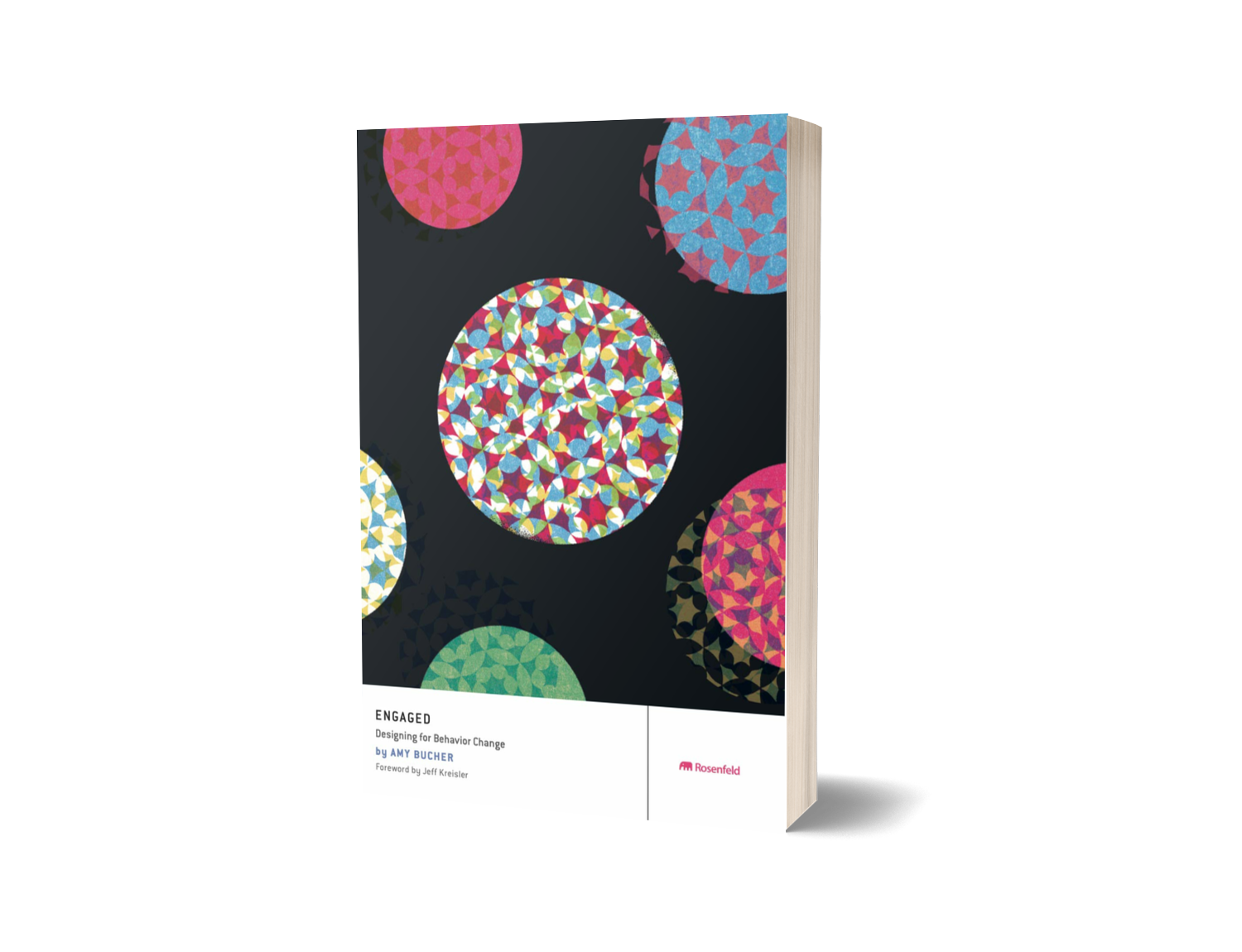VP Behavior Change Design, Mad*Pow
Amy Bucher
🕒 DURATION: 15 MIN
Engaged: Designing for Behavior Change
Presented by


INTERACTIVE CASE STUDY #6
Part 2

Welcome to the second part of this Habit Weekly Pro case study 👋





Did you miss Part 1 of the case study?
Here is what you can expect from exploring this case study



All Levels
LEVEL 🏆
Engaged: Designing for Behavior Change
This case study is suitable for both beginner & expert level behavioral designers. Perfect for anyone who wants to explore designing for digital behavior change.
Book Deep-DIve
TYPE 💡
Learners can expect to learn the key tools and insights from the book. The aim is to help you understand how to apply the main concepts using real-world examples.
Cheet Sheet + More
BONUS RESOURCES 🎁
- Downloadable cheat sheet
- Additional readings
⏱️ DURATION: 15 minutes
INTERACTIVE CASE STUDY #5
Hi again! I’m Amy Bucher, author of Engaged: Designing for Behavior Change, and Vice President of Behavior Change Design at Mad*Pow.





“An incredibly comprehensive and intelligent guidebook for designing products and services that change people’s lives.”
— Nir Eyal,
Bestselling author of Hooked and Indistractable
In part 1 of this case study, we became familiar with how to design for the psychological needs of competence and autonomy.



Designing for relatedness 🤝
5.
4.
1.
2.
3.
Ethical considerations 👀
Design for the future self 🔮
Putting Behavior Change Design into practice 🛠
Cheat sheet to download ✅
Presentation Overview


In this case study, we'll explore the final psychological need plus much more, including ethical considerations and how to get started with Behavior Change Design.




Designing for relatedness 🤝
5.
4.
1.
2.
3.
Ethical considerations 👀
Design for the future self 🔮
Putting Behavior Change Design into practice 🛠
Cheat sheet to download ✅
Presentation Overview



Designing for Relatedness




The last basic psychological need is relatedness. In Engaged, I show how both actual human support and technology can fill this need for people.

People don’t want to feel like they’re alone. Behavior change designers have tons of tools to help their users put themselves into the bigger picture of humanity.”



The last basic psychological need is relatedness. In Engaged, I show how both actual human support and technology can fill this need for people.


People don’t want to feel like they’re alone. Behavior change designers have tons of tools to help their users put themselves into the bigger picture of humanity.




“Social connections provide a variety of practical and psychological benefits. Other people can lend a hand to solve a challenging problem, offer moral support or advice for someone who needs a boost, or provide a positive role model to emulate. And many studies prove that being around people they like and care about makes people happier. In the context of behavior change specifically, some of the most important functions of social support include strengthening people’s purpose, offering them concrete assistance with achieving goals, providing teaching and accountability, and helping people occupy the right head space to be productive with behavior change activities.” -p. 174-175
Image from Noom




Social connections provide a variety of practical and psychological benefits. Other people can lend a hand to solve a challenging problem, offer moral support or advice for someone who needs a boost, or provide a positive role model to emulate.


Example from Noom





And many studies prove that being around people they like and care about makes people happier.

Example from Wisdo






In the context of behavior change specifically, some of the most important functions of social support include strengthening people’s purpose, offering them concrete assistance with achieving goals, providing teaching and accountability...

Example from StickK






...and helping people occupy the right head space to be productive with behavior change activities.

Example from SuperBetter





Accountability, competition, and informational support are all good reasons to let people connect 🙋.
Privacy, sensitivity of information, and the potential to be misleading or unhelpful are reasons why it may be better not to let people connect 🙅.




Be careful about whether and how to connect people together inside your product. Social networking is not an automatic solution to support relatedness. Make sure that any social connection is serving a bigger purpose than just social. And consider how you’ll monitor any social functionality to prevent bad actors from abusing it.






Have you ever named an inanimate object?
Maybe your car? Congratulations, you’ve anthropomorphized! It’s a totally natural thing humans do that forges an emotional bond with an object.




Sometimes it’s either not practical to connect people to each other, or you’ve decided it’s not the optimal choice for your users. The way you create your technology can help fill some of the social needs people have without there being another person involved.




The responsiveness of your tech, the tone of your content, and the way you do or don’t personalize the experience can all make people feel more seen and cared for.

Duolingo's mascot owl "Duo"




Psychologist Kip Williams studies ostracism and loneliness. A video game that he created for some of his studies had study participants controlling the hand at the bottom of the screen for a game of catch.





The pre-programmed players would eventually ostracize the participant from the game. Even when they knew it was programmed, people were left feeling angry, sad, and hurt. Our need for connection is powerful.





Human beings are so hungry for connection that we seek it with inanimate objects. We can feel emotionally tied to something even as we know full well that it’s not a living being. This can actually be a good thing as it helps fill our need for relatedness--or a bad one if it leaves us feeling rejected or isolated.

PARO the robot seal



“Personalization is the Swiss Army Knife of the behavior change design toolkit. It can help you craft appropriate goals and milestones, deliver the right feedback at the right time, and offer users meaningful choices in context. It can also help forge an emotional connection between users and technology when it’s applied in a way that helps users feel seen and understood,” - p. 206



Designers can take advantage of the human search for connection. Getting users to feel a relationship with your product is easier when you use tools like personalization that make it easy for people to see human-like qualities in technology.

Spotify's personalized daily playlists



Let your personality shine! Authenticity garners deeper reactions from people than over-engineered polish. Not everyone will like you, but it makes it easier for some people to love you.
People will form an emotional bond with a product more quickly if it mimics human characteristics. When IBM was training Watson to be on Jeopardy, one of the hardest parts was getting it to understand subtext and metaphor.


Example from IBM





Let your personality shine! Authenticity garners deeper reactions from people than over-engineered polish. Not everyone will like you, but it makes it easier for some people to love you.
It can be delightful when a chatbot, like Woebot, seems to pick up on decidedly human ways of communicating like using “chill” to mean relax, and responding with appropriate gifs.

Example from IBM





Building Trust & Ethical Considerations




Interventions have to do two things to be successful. They have to have willing users. That means they need to earn people’s trust.

People have to use the intervention, and the intervention has to work.



And, they have to produce results. That means solving the very thorny problem of designing for a future self who doesn’t yet exist.




I break earning user trust into two main categories:
- Earn the trust
- Communicate why you deserve the trust




First, in order to earn the trust, your product has to live into its promises.




That might mean protecting user data against hacking, not selling user data to third parties without giving users a real chance to opt out, or building your product with careful attention to the best science so users have the best possible chance of achieving their goals.





Secondly, in order to communicate why you deserve the trust, you have to tell your users why they should trust you. This takes direct and indirect forms. I’ll share some of the top ways interventions can do this.




The tactics that can be used to make interventions trustworthy are used throughout the user experience: In the product marketing, during onboarding, in day-to-day use, and finally in a user’s exit from the product.



Trustworthy products checklist
✅ Protect people’s data
✅ Ask permission to use data, and give a good reason for why it is needed
✅ Establish their credibility by sharing the expertise and science behind their design
✅ Offer clear, easy-to-understand legalese
✅ Make it easy for users to graduate or move on when the time comes



Be on the lookout for opportunities to help users trust you at each point in the journey.



Trustworthy products checklist
✅ Protect people’s data
✅ Ask permission to use data, and give a good reason for why it is needed
✅ Establish their credibility by sharing the expertise and science behind their design
✅ Offer clear, easy-to-understand legalese
✅ Make it easy for users to graduate or move on when the time comes



After so many high-profile data breaches and misuses of people’s information, it’s no surprise that people are often skeptical of technology.






A good behavior change design intervention earns the trust and respect of its users by being transparent, credible, and protective of data.



Throughout Engaged, I try to point out some of the ways in which behavior change design can be abused or misused. It’s important to be as ethical as possible. Not only is it the right thing to do, but it’s necessary for long-term success.

It is easier to earn someone’s trust in the first place than to regain it after it’s lost.



I could write a whole book just about the various ethical considerations in behavior change design. But we don’t have time for that! So here are a few top things to consider.




The human subjects guidelines established by the American Psychological Association (APA) and used by Institutional Review Boards (IRBs) at universities and research institutions around the United States provide good baseline guidance for doing ethical research.

Ethical considerations in behavior change design.
1. Human subjects guidelines from psychology




In fact, if you want to use your research to go beyond just product design--if you want to publish it to benefit the general knowledge base--you should submit your plans to an IRB for review. They’ll help make sure you’re keeping your participants’ risks as low as possible.

Ethical considerations in behavior change design.
1. Human subjects guidelines from psychology





There are all kinds of ideation tools in the design world that can help think through worst case scenarios and design to prevent them.



Three that I like are the Tarot Cards of Tech from Artefact, the Designer’s Critical Alphabet by Lesley-Ann Noel, and the Ethical Explorer by Omidyar Network.



Ethical considerations in behavior change design.
1. Human subjects guidelines from psychology
2. Design brainstorming tools




Use these tools during your design process to stretch your thinking and catch potential ethical missteps.



Ethical considerations in behavior change design.
1. Human subjects guidelines from psychology
2. Design brainstorming tools




Yes, you are a user as well as a designer, but you are not all users. Make sure to include the people who will ultimately use your intervention in your research and design process.

Ethical considerations in behavior change design.
1. Human subjects guidelines from psychology
2. Design brainstorming tools



If possible, hire and collaborate with diverse design teams to benefit from multiple viewpoints and experiences.

Ethical considerations in behavior change design.
1. Human subjects guidelines from psychology
2. Design brainstorming tools
3. Be participatory and inclusive




It’s helpful to adopt the mindset of designing with not for. Participatory design is one approach you can use in your research to get your users generating solution ideas that work for them.




Design for the Future Self




If I had to boil behavior change down to one wicked question, it would be this: How can we design for our future selves?

How can we design for our future selves?



So much behavior change involves making short term sacrifices for potential long term gain. Our brains are not wired to make that easy.





There are a few ways we can tackle the challenge of designing for the future self. One is to minimize or distract from those short term sacrifices.



We can make the change process more pleasant, by helping people pay attention to its benefits or coaching them to shape their environment so they’re not constantly having to make hard choices (e.g. do not buy that ice cream!).





Design features like streaks don’t just provide feedback on progress. They make tough journeys feel a little easier by giving people a sense of accomplishment early and often.


Example from Loselt





We can also help make the future rewards feel more real and, well, rewarding. The idea of our future self is abstract. It’s both hard to believe that we can change, and easy to imagine that our future self will be a totally different, better version of who we are today.




So we make big plans but then don’t take the steps needed to achieve them. Research has shown that creating empathy for our future self can help spur action today.




Some apps do this by creating realistic aged images of people. It can be hard to put money into a retirement fund instead of taking a vacation now, but the aged photo reminds people that it’s all for their own benefit.


Example from Medical Avatar




The image here is from Medical Avatar, which can show the effect of different health choices on a person’s body.


Example from Medical Avatar



Putting Behavior Change Design into practice




If you’ve never done behavior change design before, know that it’s a process! You won’t change your entire toolkit overnight. Start with a handful of tactics to bring bits of behavior change design into your process.




I’ll share three of the tools I think are easiest for new behavior change designers to use (and can make the most impact on your project).

Three first step in getting started using behavioral-change design
1. Write a literation review 📚
2. Create an outcomes logic map 🗺
3. User theory-based lenses for brainstorms 💡



Literature reviews help you ground your work in research that’s been done before. It can help you more quickly arrive at solutions that deliver results.



Tactic 1: The Literation Review
Dive into existing research to see what types of interventions work in your problem space
Resources:
- Google Scholar
- ResearchGate
- Your local library
- Friends or colleagues with university database access
Or reach out to study authors on social media!




A literature review can be a formal standalone document, an introductory section in a product brief or requirements document, or supporting information in a presentation. No matter how you document it, it ensures you’re grounding your work in existing knowledge.



Tactic 1: The Literation Review
Dive into existing research to see what types of interventions work in your problem space
Resources:
- Google Scholar
- ResearchGate
- Your local library
- Friends or colleagues with university database access
Or reach out to study authors on social media!




The literature review’s tagline on a dating site would be “Don’t reinvent the wheel.”





The next tactic is to create an outcome logic map.



Tactic 2: Create an outcome logic map
The outcomes logic map is a tool used in program evaluation research. It generally produced as a document that shows the types of outcomes your product might produce over time.
The word “logic” refers to the fact that each measurement should logically connect to the others in the sequence.




Remember this guy? The outcomes map is one of the most powerful tools in the behavior change kit.

Baseline Measurements
Leading
Lagging
Measurement time frame
Participation & Engagement (exposure metrics)
Behavior
Changes
Long-term Outcomes



Getting into the practice of outlining exactly what behaviors you want your users to do, and how you can measure whether it’s happening, will influence the design decisions you make later in the process.

Baseline Measurements
Leading
Lagging
Measurement time frame
Participation & Engagement (exposure metrics)
Behavior
Changes
Long-term Outcomes



Bonus points if you actually put the outcomes map to use and collect data!

Baseline Measurements
Leading
Lagging
Measurement time frame
Participation & Engagement (exposure metrics)
Behavior
Changes
Long-term Outcomes



The outcomes logic map’s tagline on a dating site would be “A goal without a plan is just a wish.”





Brainstorms are a fun segue from problem definition into solution seeking. Try using lenses--concepts from behavior change science that serve as categories for new ideas.



Tactic 3: Lensed Brainstorm
Example lenses:
- Basic psychological needs from self-determination theory (autonomy, competence, relatedness)
- Behavioral determinants from COM-B and the Behaviour Change Wheel (capability, opportunity, motivation)
- The components of habits (cues, behaviors, rewards)




Not every lens will be equally fruitful, but many of them will guide you toward design ideas that you would not have otherwise had.



Tactic 3: Lensed Brainstorm
Example lenses:
- Basic psychological needs from self-determination theory (autonomy, competence, relatedness)
- Behavioral determinants from COM-B and the Behaviour Change Wheel (capability, opportunity, motivation)
- The components of habits (cues, behaviors, rewards)




The lensed brainstorm’s tagline on a dating site would be “There are no facts, only interpretations.”


Well done, you've now completed this case study!🎉



CASE STUDY COMPLETED
Part2
Engaged: Designing for Behavior Change










We covered a lot of ground in this two-part case study based on my book Engaged. I hope that this cheat sheet can be helpful and I recommend checking out the book to dive deeper into how we can design for behavior change!

CHEAT SHEET
Here's a summary of the key insights from this two-part case study. For a deeper dive into all things behavior change design, make sure to check out Engaged.
BEHAVIORAL RESOURCE






SURVEY
Please complete this 1-min survey to help me further improve these case studies. Thanks! 😊

